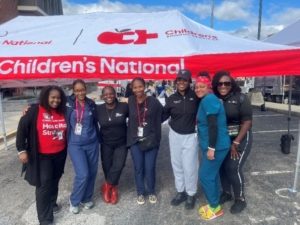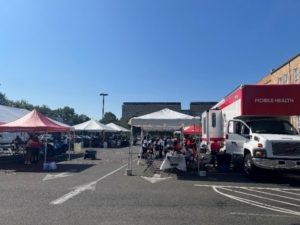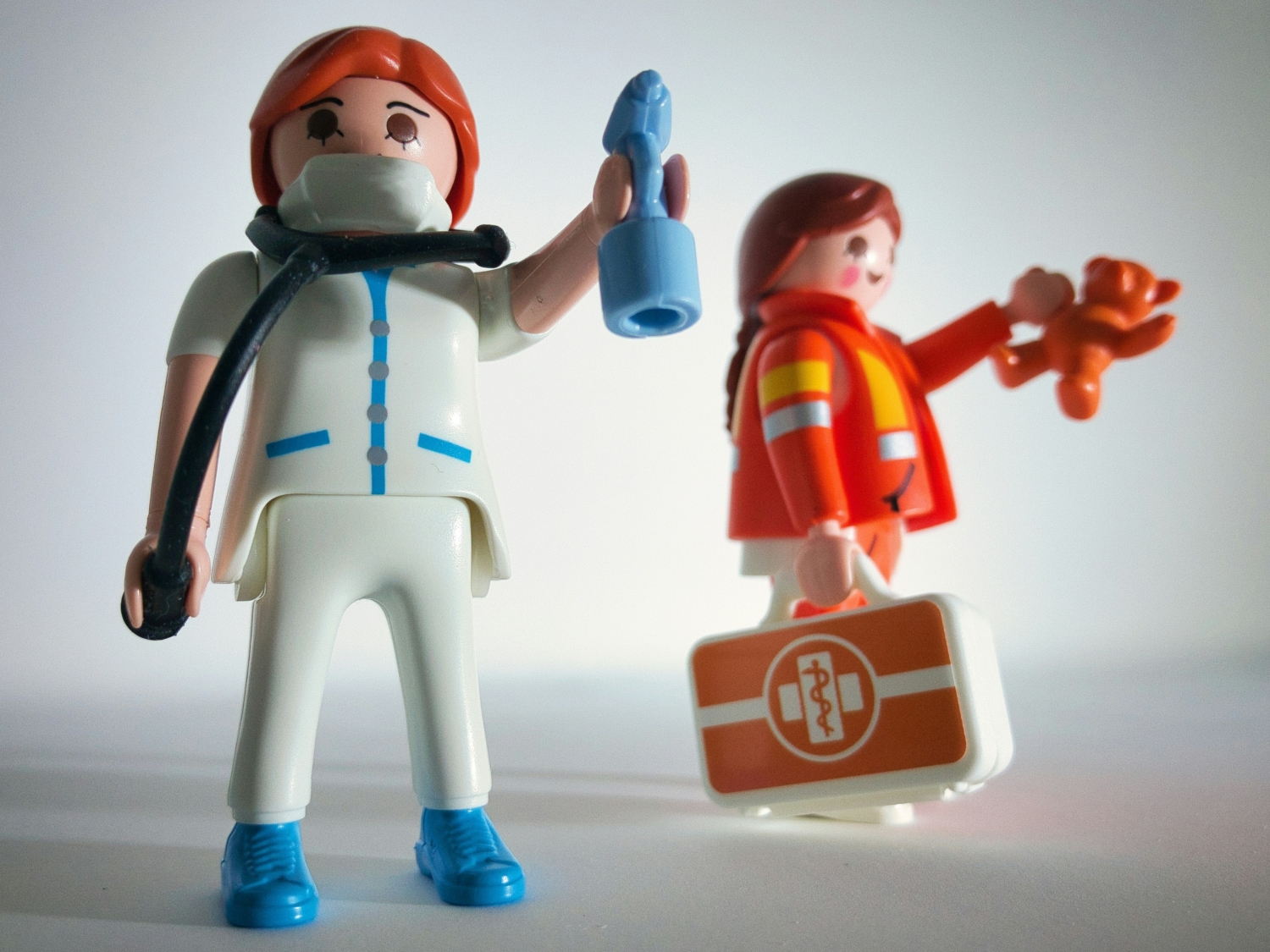For pediatric health systems, mobile healthcare, and School-Based Health Centers (SBHCs) provide accessible high-quality health care to children and families that can improve health outcomes and reduce health disparities. As an extension of the primary care medical home, these innovative and comprehensive programs offer medical check-ups, immunizations, behavioral health screenings and dental services to the community at convenient times and locations.
Children’s National Mobile Medical Program is committed to combating pediatric health disparities by increasing access to quality, culturally competent healthcare for medically under-resourced children in the District of Columbia and neighboring Prince George’s County, Maryland. The program delivers place-based care where children and families live, learn, work and play. It has a long history of serving community organizations and schools in these communities reaching more than 3,500 families annually at the program’s peak. Over the past decade, the program’s visit volumes declined due to many factors including: focused efforts to connect families with fixed facility medical homes, leadership turn over and dwindling investment in community partnerships. The latter is mission critical to a thriving mobile medical program. During the COVID-19 pandemic, the program was revitalized when linkages to healthcare were weakened due to public health stay-at-home orders. Our partnerships with the United Health Foundation, DC Department of Health, Children’s Health Fund and a host of committed community organizations have enabled Children’s National to provide comprehensive mobile healthcare to over 1,500 children annually who are not currently being served by healthcare providers.

A Family Affair Immunization Event in July 2023

A Family Affair Immunization Event in July 2023
Mobile healthcare programs can have a greater impact when they are collaborating closely with schools and community partners. At the 2024 National School-Based Health Care Conference, Hope Rhodes, MD, MPH, Medical Director of the Children’s Health Center at THEARC and the Mobile Medical Program presented on how engaging school nurses, community partners and policy makers has helped to strengthen mobile healthcare delivery in Washington, D.C.. The conference theme, “Engaging Communities, Fostering Partnerships” elevated innovative ways SBHCs and other school connected programs are working with youth to increase access and reach to these programs.
School-based health centers (SBHCs) are unique health care settings for children and youth that have been proven to improve access to care, improve health outcomes and reduce health disparities.[1] With over 2,500 SBHCs serving 48 of 50 states, the District of Columbia, and Puerto Rico, there has been significant growth particularly in rural and suburban areas.[2] Children’s National currently operates 10 SBHCs in elementary schools in Montgomery County, Maryland and two SBHCs in high schools in the District of Columbia.
Children’s National was invited to present a session on Building Impactful School Partnerships to Advance Health Equity at the 2024 Maryland SBHCs Annual Conference. As Children’s National led the development of a School-Friendly Health Systems (SFHS) framework, the session gave an overview of the SFHS principles and practices and initial learnings from a national SFHS Learning Collaborative.
The SFHS framework consists of five principles, each accompanied by practices that help illuminate how a health system — from the systems level to individual providers — can support children’s health and learning. These are practices that professionals working at the intersection of healthcare and education view as emblematic of an SFHS, some already put into practice and some aspirational:
|
Dr. Julie Krueger, Medical Director of two DC SBHCs and Children’s School Services, shared examples of how they have applied the SFHS framework to the SBHC programming at Ballou Senior and Paul Laurence Dunbar High Schools.
Alignment
- SBHC staff partner with local health teachers and school leadership to determine desired health educational topics.
- SBHC staff collaborate with school staff to schedule health education sessions during class periods and split into focused small groups separated by grade and gender.
Accessibility
- SBHC staff attend school activities such as back-to-school parent events, homecoming events, and graduation events.
- SBHCs are open during school hours for sports physicals and vaccinations, especially lunch time and class breaks when students are more likely to stop in for questions.
Accountability
- SBHC staff regularly submit and review data and performance measures with funder.
- SBHC staff enable data sharing with school and the DC Department of Health specifically around annual vaccination updates and working to get students vaccinated.

Julia DeAngelo and Julie Krueger at the Maryland SBHCs Annual Conference
The session also engaged with conference attendees on strategies on how they can assess and improve the delivery of health services, programming and build impactful relationships between the education and health sector.
Children’s National Mobile Medical Program is providing services to the community this summer and fall through offering the Family Affairs weekend health event series with a primary focus on increasing access to pediatric immunizations, Flu and COVID vaccines. The shared goal is to reduce the risk of vaccine preventable diseases in schools. if schools are interested in partnering with this program, contact mobileclinic@childrensnational.org.
Children’s National also plans to convene the SFHS Learning Collaborative this fall to build a comprehensive SFHS roadmap and toolkit. For more information, contact SchoolPartnerships@childrensnational.org.
Additional Resources:
Learn more about Children’s National Mobile Medical Unit and SBHCs it operates in DC and Maryland in the 2024 Children’s National School Programs and Initiatives report at childrensnational.org/school-partnerships.
[1] Knopf JA, Finnie RK, Peng Y, et al; Community Preventive Services Task Force. School-based health centers to advance health equity: a community guide systematic review. Am J Prev Med. 2016;51(1):114–126
[2] Love HE, Schlitt J, Soleimanpour, et al; Twenty Years of School-Based Health Care Growth and Expansion. Health Affairs. May 2019. https://doi.org/10.1377/hlthaff.2018.05472
Header image by Daniele D’Andreti on Unsplash
References
[1] WKAR Public Media. Book Tells Dr. Mona Hanna Attisha’s Story of Flint Water Crisis (September 12, 2018). Available from https://www.wkar.org/health/2018-09-12/book-tells-dr-mona-hanna-attishas-story-of-flint-water-crisis.
[2] National Public Radio. It’s Been 10 Years Since the State of a Devastating Water Crisis in Flint, Mich. (April 25, 2024). Available from https://www.npr.org/2024/04/25/1247095068/its-been-10-years-since-the-start-of-a-devastating-water-crisis-in-flint-mich.
[3] U.S. Environmental Protection Agency. Memorandum of Understanding Partners on Reducing Lead Levels in Drinking Water in Schools and Child Care Facilities. (October 2019). Available from https://www.epa.gov/sites/default/files/2019-10/documents/mou_reducing_lead_in_drinking_water_in_schools_final.pdf
[4] The White House. Fact Sheet: The Biden-Harris Lead Pipe and Paint Action Plan (December 16, 2021). Available from https://www.whitehouse.gov/briefing-room/statements-releases/2021/12/16/fact-sheet-the-biden-harris-lead-pipe-and-paint-action-plan/#:~:text=%2465%20billion%20of%20Build%20Back,and%20privately%2Downed%20service%20lines.
[5] The White House. Fact Sheet on Biden-Harris Administration Announces $3 Billion to Replace Toxic Lead Pipes and Deliver Clean Drinking Water to Communities Across the Country. (May 2, 2024). Available from https://www.whitehouse.gov/briefing-room/statements-releases/2024/05/02/fact-sheet-biden-harris-administration-announces-3-billion-to-replace-toxic-lead-pipes-and-deliver-clean-drinking-water-to-communities-across-the-country/
[6] U.S. Environmental Protection Agency. Proposed Lead and Copper Rule Improvements. Available from https://www.epa.gov/ground-water-and-drinking-water/proposed-lead-and-copper-rule-improvements
[7] U.S. Centers for Disease Control and Prevention. Testing for Lead Position in Children (April 16, 2024). Available from https://www.cdc.gov/lead-prevention/testing/index.html#:~:text=The%20best%20way%20to%20know%20if%20a%20child,and%20have%20no%20record%20of%20ever%20being%20tested..
About the author

Julia DeAngelo, MPH
Program Manager for School Strategies within the Child Health Advocacy Institute at Children's National Hospital



